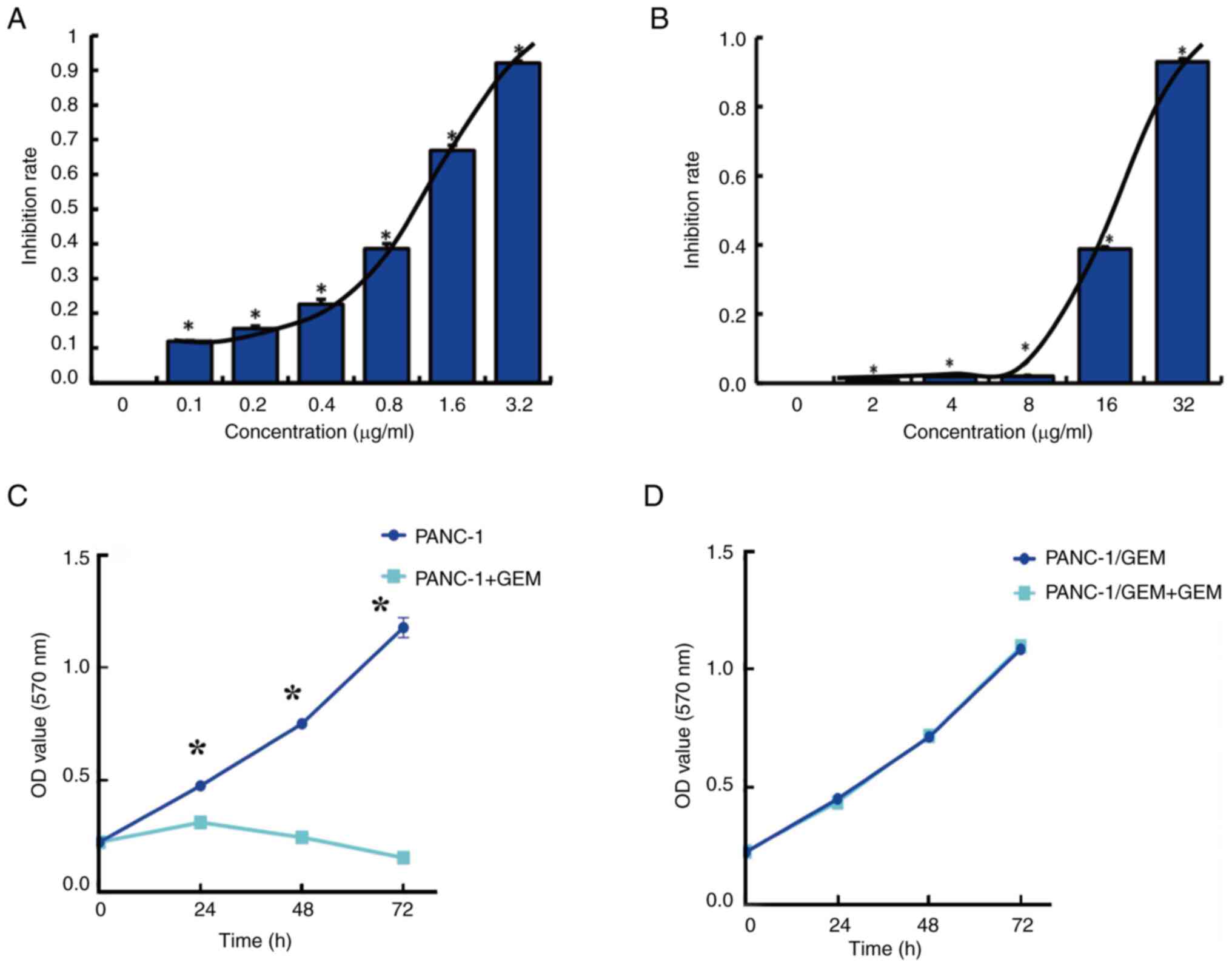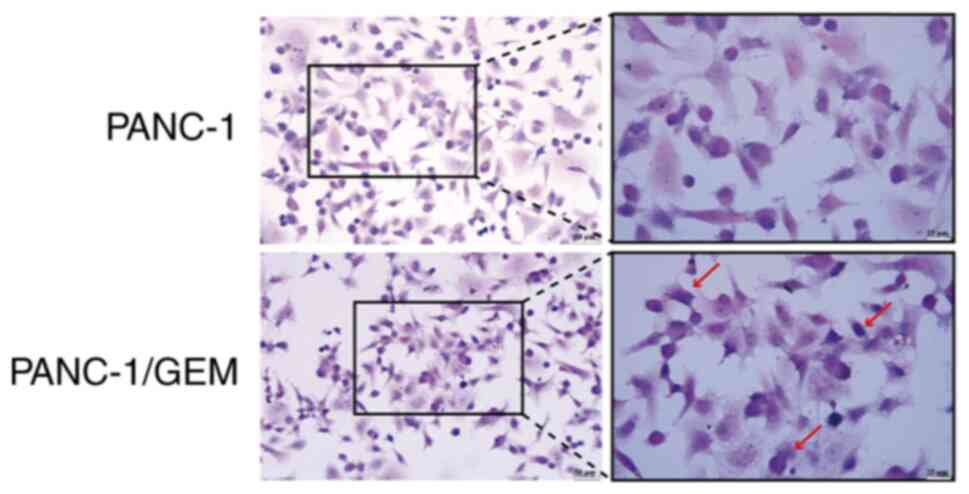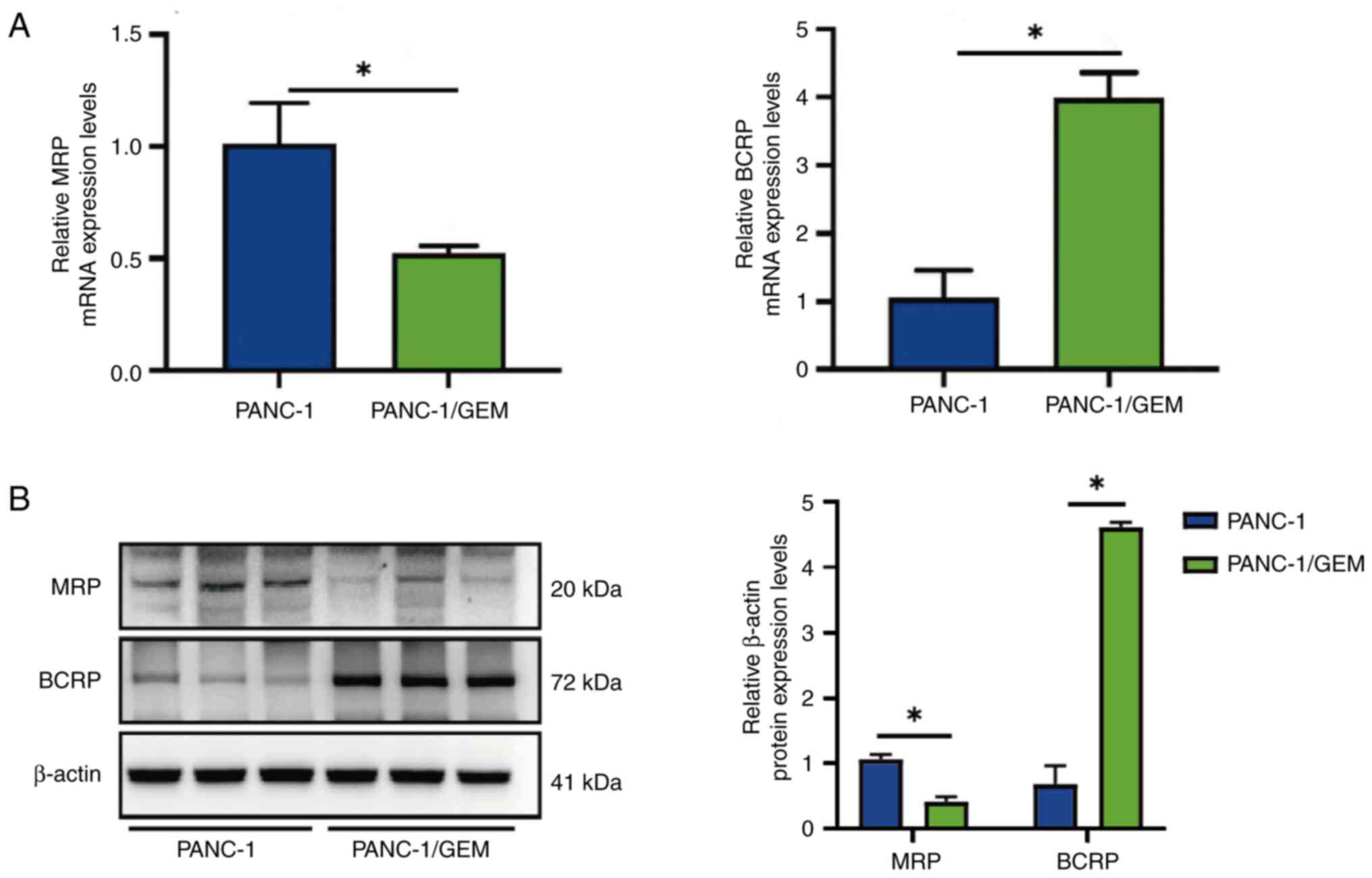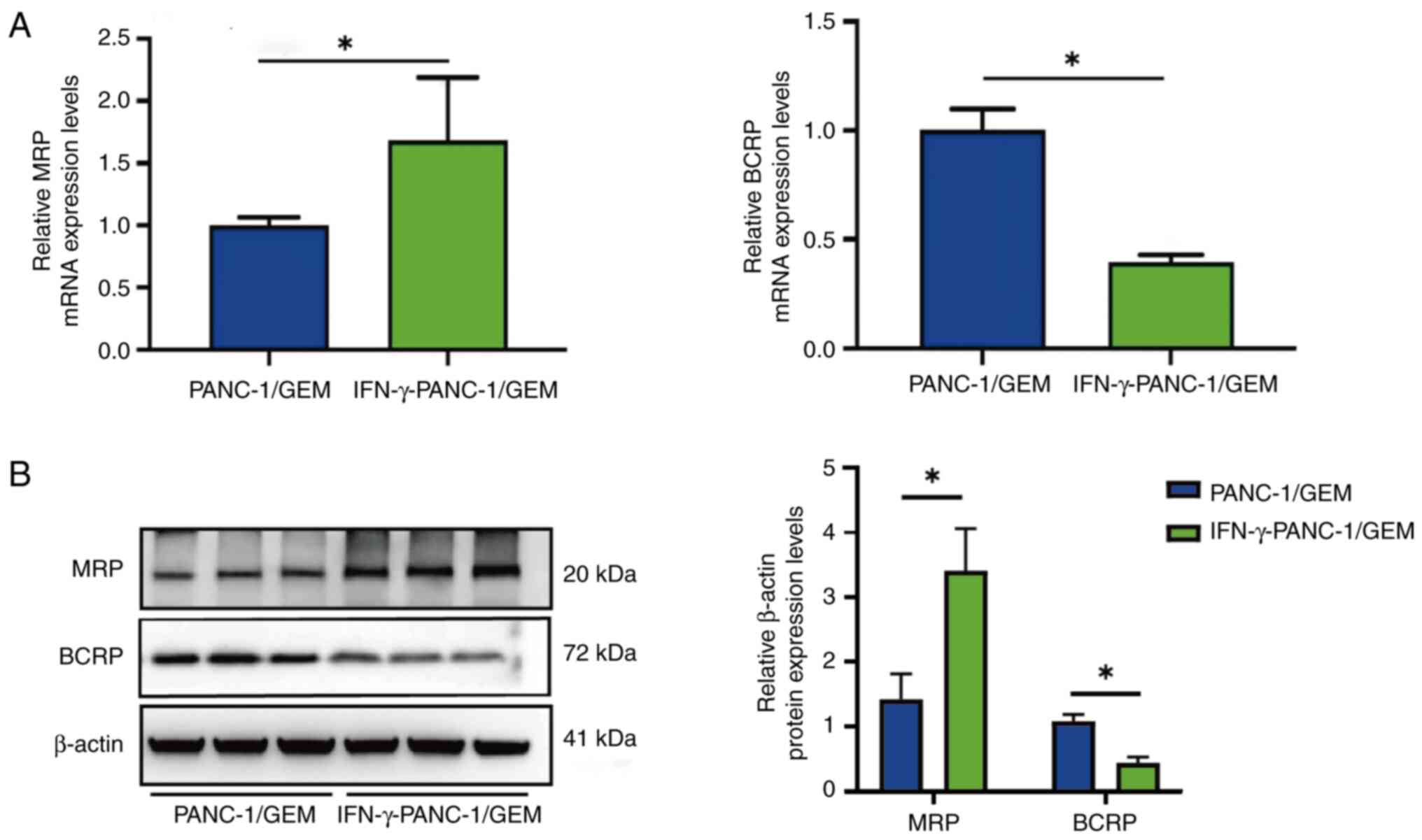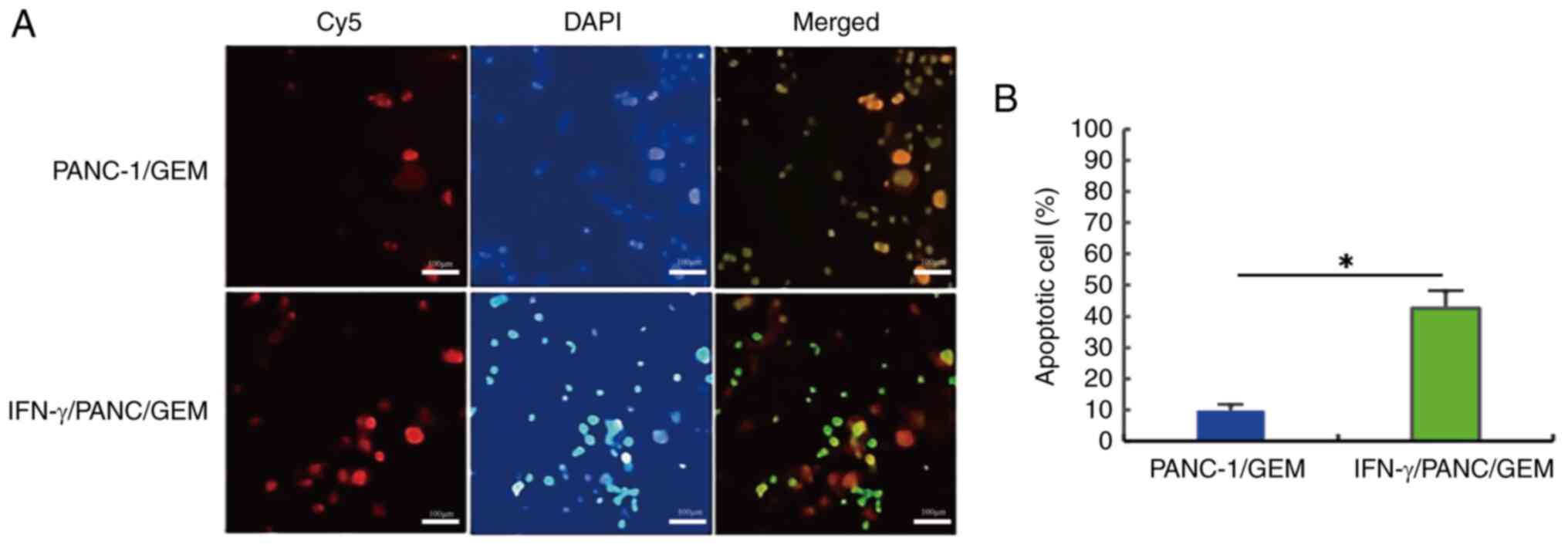|
1
|
Luchini C, Grillo F, Fassan M, Vanoli A,
Capelli P, Paolino G, Ingravallo G, Renzulli G, Doglioni C, D'Amuri
A, et al: Malignant epithelial/exocrine tumors of the pancreas.
Pathologica. 112:210–226. 2020. View Article : Google Scholar : PubMed/NCBI
|
|
2
|
Haeberle L and Esposito I: Pathology of
pancreatic cancer. Transl Gastroenterol Hepatol. 4:502019.
View Article : Google Scholar : PubMed/NCBI
|
|
3
|
Lu H, Niu F, Liu F, Gao J, Sun Y and Zhao
X: Elevated glypican-1 expression is associated with an unfavorable
prognosis in pancreatic ductal adenocarcinoma. Cancer Med.
6:1181–1191. 2017. View Article : Google Scholar : PubMed/NCBI
|
|
4
|
Zhou C, Yi C, Yi Y, Qin W, Yan Y, Dong X,
Zhang X, Huang Y, Zhang R, Wei J, et al: LncRNA PVT1 promotes
gemcitabine resistance of pancreatic cancer via activating
Wnt/β-catenin and autophagy pathway through modulating the
miR-619-5p/Pygo2 and miR-619-5p/ATG14 axes. Mol Cancer. 19:1182020.
View Article : Google Scholar : PubMed/NCBI
|
|
5
|
Wu Z, Li S and Zhu X: The mechanism of
stimulating and mobilizing the immune system enhancing the
anti-tumor immunity. Front Immunol. 12:6824352021. View Article : Google Scholar : PubMed/NCBI
|
|
6
|
McDonald OG: The biology of pancreatic
cancer morphology. Pathology. 54:236–247. 2022. View Article : Google Scholar : PubMed/NCBI
|
|
7
|
Amrutkar M and Gladhaug IP: Pancreatic
cancer chemoresistance to gemcitabine. Cancers. 9:1572017.
View Article : Google Scholar : PubMed/NCBI
|
|
8
|
Castro F, Cardoso AP, Gonçalves RM, Serre
K and Oliveira MJ: Interferon-gamma at the crossroads of tumor
immune surveillance or evasion. Front Immunol. 9:8472018.
View Article : Google Scholar : PubMed/NCBI
|
|
9
|
Narayanan P, Farghadani R, Nyamathulla S,
Rajarajeswaran J, Thirugnanasampandan R and Bhuwaneswari G: Natural
quinones induce ROS-mediated apoptosis and inhibit cell migration
in PANC-1 human pancreatic cancer cell line. J Biochem Mol Toxicol.
36:e230082022. View Article : Google Scholar : PubMed/NCBI
|
|
10
|
He J, Bugde P, Li J, Biswas R, Li S, Yang
X, Tian F, Wu Z and Li Y: Multidrug resistance protein 5 affects
cell proliferation, migration and gemcitabine sensitivity in
pancreatic cancer MIA Paca-2 and PANC-1 cells. Oncol Rep. 51:72024.
View Article : Google Scholar : PubMed/NCBI
|
|
11
|
Chen M, He M, Song Y, Chen L, Xiao P, Wan
X, Dai F and Shen P: The cytoprotective role of gemcitabine-induced
autophagy associated with apoptosis inhibition in triple-negative
MDA-MB-231 breast cancer cells. Int J Mol Med. 34:276–282. 2014.
View Article : Google Scholar : PubMed/NCBI
|
|
12
|
Nowak AK, Robinson BW and Lake RA:
Gemcitabine exerts a selective effect on the humoral immune
response: Implications for combination chemo-immunotherapy. Cancer
Res. 62:2353–2358. 2002.PubMed/NCBI
|
|
13
|
Zhang QB, Ye RF, Ye LY, Zhang QY and Dai
NG: Isocorydine decrease gemcitabine-resistance by inhibiting
epithelial-mesenchymal transition via STAT3 in pancreatic cancer
cells. Am J Transl Res. 12:3702–3714. 2020.PubMed/NCBI
|
|
14
|
Liu L, Yang L, Chang H, Chen YN, Zhang F,
Feng S, Peng J, Ren CC and Zhang XA: CP-31398 attenuates
endometrial cancer cell invasion, metastasis and resistance to
apoptosis by downregulating MDM2 expression. Int J Oncol.
54:942–954. 2019.PubMed/NCBI
|
|
15
|
Zhu F, Wu Q, Ni Z, Lei C, Li T and Shi Y:
miR-19a/b and MeCP2 repress reciprocally to regulate multidrug
resistance in gastric cancer cells. Int J Mol Med. 42:228–236.
2018.PubMed/NCBI
|
|
16
|
Zhu K, Fang W, Chen Y, Lin S and Chen X:
TNF-related apoptosis-inducing ligand enhances vinorelbine-induced
apoptosis and antitumor activity in a preclinical model of
non-small cell lung cancer. Oncol Rep. 32:1234–1242. 2014.
View Article : Google Scholar : PubMed/NCBI
|
|
17
|
Wang B, Shen C, Li Y, Zhang T, Huang H,
Ren J, Hu Z, Xu J and Xu B: Oridonin overcomes the gemcitabine
resistant PANC-1/Gem cells by regulating GST pi and LRP/1 ERK/JNK
signalling. Onco Targets Ther. 12:5751–5765. 2019. View Article : Google Scholar : PubMed/NCBI
|
|
18
|
Zhou Y, Zhou Y, Yang M, Wang K, Liu Y,
Zhang M, Yang Y, Jin C, Wang R and Hu R: Digoxin sensitizes
gemcitabine-resistant pancreatic cancer cells to gemcitabine via
inhibiting Nrf2 signaling pathway. Redox Biol. 22:1011312019.
View Article : Google Scholar : PubMed/NCBI
|
|
19
|
Livak KJ and Schmittgen TD: Analysis of
relative gene expression data using real-time quantitative PCR and
the 2(−Delta Delta C(T)) method. Methods. 25:402–408. 2001.
View Article : Google Scholar : PubMed/NCBI
|
|
20
|
Pekarek L, Fraile-Martinez O,
Garcia-Montero C, Saez MA, Barquero-Pozanco I, Del Hierro-Marlasca
L, de Castro Martinez P, Romero-Bazán A, Alvarez-Mon MA, Monserrat
J, et al: Clinical applications of classical and novel biological
markers of pancreatic cancer. Cancers. 14:18662022. View Article : Google Scholar : PubMed/NCBI
|
|
21
|
Desai NV, Sliesoraitis S, Hughes SJ,
Trevino JG, Zlotecki RA, Ivey AM and George TJ Jr:
Multidisciplinary neoadjuvant management for potentially curable
pancreatic cancer. Cancer Med. 4:1224–1239. 2015. View Article : Google Scholar : PubMed/NCBI
|
|
22
|
Principe DR, Underwood PW, Korc M, Trevino
JG, Munshi HG and Rana A: The current treatment paradigm for
pancreatic ductal adenocarcinoma and barriers to therapeutic
efficacy. Front Oncol. 11:6883772021. View Article : Google Scholar : PubMed/NCBI
|
|
23
|
Fraile-Martinez O, García-Montero C,
Pekarek L, Saz JV, Álvarez-Mon MÁ, Barrena-Blázquez S,
García-Honduvilla N, Buján J, Asúnsolo Á, Coca S, et al: Decreased
survival in patients with pancreatic cancer may be associated with
an increase in histopathological expression of inflammasome marker
NLRP3. Histol Histopathol. 39:35–40. 2024.PubMed/NCBI
|
|
24
|
Ortega MA, Fraile-Martinez O, Pekarek L,
García-Montero C, Alvarez-Mon MA, Castellanos AJ, García-Honduvilla
N, Buján J, Alvarez-Mon M, Sáez MA, et al: Oxidative stress markers
are associated with a poor prognosis in patients with pancreatic
cancer. Antioxidants (Basel). 11:7592022. View Article : Google Scholar : PubMed/NCBI
|
|
25
|
Jorgovanovic D, Song M, Wang L and Zhang
Y: Roles of IFN-γ in tumor progression and regression: A review.
Biomark Res. 8:492020. View Article : Google Scholar : PubMed/NCBI
|
|
26
|
Xin L, Xiao W, Che L, Liu J, Miccio L,
Bianco V, Memmolo P, Ferraro P, Li X and Pan F: Label-free
assessment of the drug resistance of epithelial ovarian cancer
cells in a microfluidic holographic flow cytometer boosted through
machine learning. ACS Omega. 6:31046–31057. 2021. View Article : Google Scholar : PubMed/NCBI
|
|
27
|
Patel H, Wu ZX, Chen Y, Bo L and Chen ZS:
Drug resistance: From bacteria to cancer. Mol Biomed. 2:272021.
View Article : Google Scholar : PubMed/NCBI
|
|
28
|
Qin T, Chen K, Li J, Qian W, Xiao Y, Wu E,
Ma J, Chen Z, Wang Z, Ma Q and Wu Z: Heat shock factor 1 inhibition
sensitizes pancreatic cancer to gemcitabine via the suppression of
cancer stem cell-like properties. Biomed Pharmacother.
148:1127132022. View Article : Google Scholar : PubMed/NCBI
|
|
29
|
Miller DW, Fontain M, Kolar C and Lawson
T: The expression of multidrug resistance-associated protein (MRP)
in pancreatic adenocarcinoma cell lines. Cancer Lett. 107:301–306.
1996. View Article : Google Scholar : PubMed/NCBI
|
|
30
|
Washio I, Nakanishi T, Ishiguro N,
Yamamura N and Tamai I: Impact of breast cancer resistance protein
expression on the in vitro efficacy of anticancer drugs in
pancreatic cancer cell lines. Drug Metab Dispos. 46:214–222. 2018.
View Article : Google Scholar : PubMed/NCBI
|
|
31
|
Mojic M, Takeda K and Hayakawa Y: The dark
side of IFN-γ: Its role in promoting cancer immunoevasion. Int J
Mol Sci. 19:892017. View Article : Google Scholar : PubMed/NCBI
|















